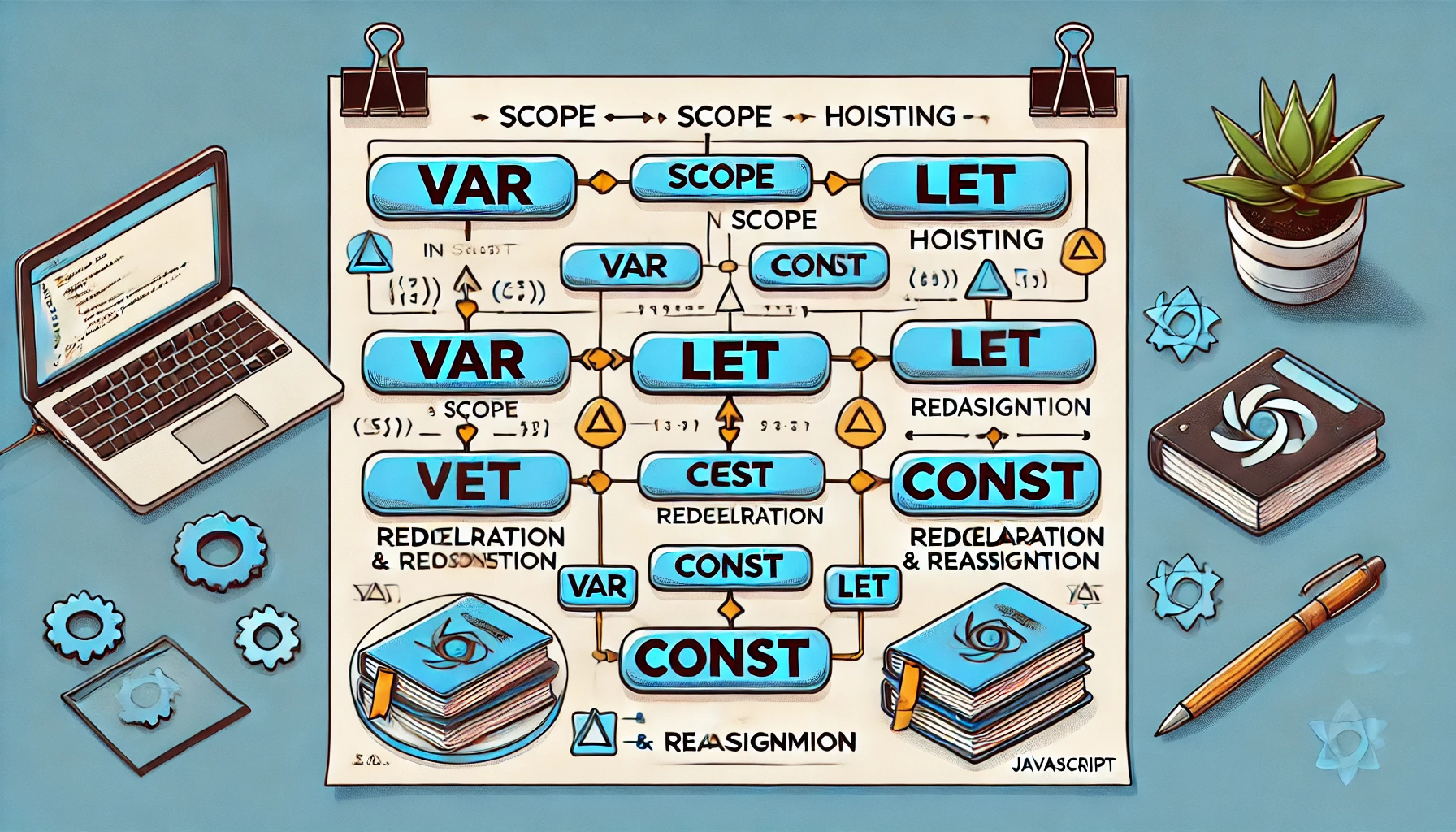Sajiron
Understanding the Difference Between var, let, and const in JavaScript

Learn the critical differences between JavaScript’s var, let, and const—scope, hoisting, mutability, and best practices to write clean, bug-free code.
Introduction to JavaScript Variables
JavaScript developers often encounter var, let, and const when declaring variables. While var was traditionally used, let and const were introduced in ES6 (ECMAScript 2015) to address scoping issues and improve code maintainability. Understanding their differences is essential for writing robust and bug-free JavaScript code.
In this guide, we'll explore the key differences between var, let, and const, and provide best practices to optimize your JavaScript projects.
var: var keyword has been present since JavaScript was created. However, it has several drawbacks due to its scoping behavior.
let/const: let/const keywords were introduced in ES6 to provide better block scoping and prevent issues caused by var.
Now, let's discuss the key differences between var, let, and const variables.
1. Variable Scope in JavaScript: var vs. let/const
Variable scope defines where a variable can be accessed.
Function Scope with var
var is function-scoped, meaning var variables are accessible within the function they are defined in, even if declared inside a block (like an if statement).
function foo() {
if (true) {
var x = 20;
}
console.log(x); // Output: 20
}
foo();Block Scope with let and const
let and const are block-scoped, meaning they are confined to the block ({}) in which they are declared. Typically, this block is the nearest pair of curly braces surrounding the declaration.
function foo() {
if (true) {
let x = 20;
}
console.log(x); // ReferenceError: x is not defined
}
foo();2. Hoisting: Why var Behaves Differently Compared to let and const
Hoisting is the mechanism by which the JavaScript engine allocates memory for variable declarations at the beginning of their scope before executing the code.
var variables are hoisted to the top of their function or global scope and initialized with undefined, meaning they can be accessed before declaration but will return undefined, which can lead to confusing behavior.
console.log(x); // Output: undefined
var x = 10;let/const variables are hoisted but not initialized, meaning they exist in a Temporal Dead Zone (TDZ) until their declaration is reached. Accessing them before declaration results in a ReferenceError.
console.log(x); // ReferenceError
let x = 10;3. Reassigning and Redeclaring Variables
Keyword | Redeclare? | Reassign? |
| ✅ Yes | ✅ Yes |
| ❌ No | ✅ Yes |
| ❌ No | ❌ No |
Why avoid var? You can redeclare a variable with var in the same scope without an error.
var count = 5;
var count = 10; // No errorSafer Code with let and const
let score = 100;
score = 200; // Allowed
const MAX_USERS = 10;
MAX_USERS = 20; // TypeError4. Mutability: const Doesn’t Mean Immutable
The const keyword is used to declare constants, but this does not mean the value is immutable. const variables behave like let variables, except they cannot be reassigned after declaration.
const foo = { bar: "a" };
foo.bar = "b"; // Allowed (mutating content)
foo = { bar: "c" }; // TypeError (reassigning reference)5. Global Scope and the window Object
In browsers, var in the global scope attaches to the window object, risking naming collisions. let and const stay private:
var globalVar = "I’m global!";
let privateLet = "I’m not on window";
console.log(window.globalVar); // "I’m global!"
console.log(window.privateLet); // undefined6. Solving Loop Issues with Block Scoping
A classic var pitfall in loops with closures:
for (var i = 0; i < 3; i++) {
setTimeout(() => console.log(i)); // Logs 3, 3, 3
}Fix with let:
for (let j = 0; j < 3; j++) {
setTimeout(() => console.log(j)); // Logs 0, 1, 2
}In the first loop (var), there is a single shared i, so by the time setTimeout runs, i is 3 for all iterations. In the second loop (let), each iteration gets a new i, preserving its value when setTimeout executes, resulting in 0, 1, 2.
Summary
Feature |
|
|
|
Scope | Function | Block | Block |
Hoisting | Yes (initialized as | Yes (TDZ applies) | Yes (TDZ applies) |
Redeclaration | Allowed | Not allowed | Not allowed |
Reassignment | Allowed | Allowed | Not allowed |
Must be initialized | No | No | Yes |
Best Practices for JavaScript Variables
Use const by default for variables that won’t change.
Choose let when reassignment is needed.
Avoid var (legacy, error-prone).
This approach minimizes bugs and aligns with modern JavaScript (ES6+).
Conclusion
By understanding the differences between var, let, and const, developers can write cleaner, more predictable, and less error-prone JavaScript code. As a best practice, prefer const where possible, use let when necessary, and avoid var to minimize potential issues.
Recommended

# The Difference Between `null`, `undefined`, and `NaN` in JavaScript
Understand the key differences between null, undefined, and NaN in JavaScript with clear examples, use cases, and best practices for each.

Debouncing vs Throttling in JavaScript: When to Use Each
Learn the difference between debouncing and throttling in JavaScript. Improve performance and user experience with simple examples and use cases.

Mathematical Foundations for Machine Learning in JavaScript
Explore essential math for machine learning—vectors, matrices, calculus, and probability—explained with beginner-friendly JavaScript code.

Understanding Data Preprocessing in JavaScript
Learn data preprocessing in JavaScript for Machine Learning. Clean, transform, and structure data with practical examples to boost ML model accuracy!